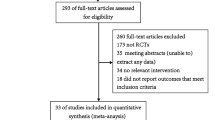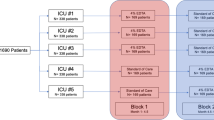Abstract
Objective
Antibioticcoated intravascular catheters may be an effective means of decreasing bacterial colonization and subsequent catheter-related infection. The present study was designed to investigate the retention of the antibiotic teicoplanin on a hydromer-coated intravenous catheter and the effect of this antibiotic coating on catheter bacterial colonization.
Design
A prospective, randomized pilot study.
Setting
Operating rooms (ORs) and an intensive care unit (ICU) at a university hospital.
Patients
A consecutive group of 20 male patients undergoing major abdominal surgery.
Interventions
Control (C,n=10) or teicoplanin-coated (T;n=10) single-lumen central venous catheters were inserted before surgery in the OR. Catheters were withdrawn at the discretion of the physicians in the ICU after various periods.
Measurements
The teicoplanin content of the catheter material was assessed using a bioassay withBacillus subtilis after complete elution of the antibiotic from the catheter. Bacterial colonization was measured using a quanitative culture technique after the catheter lumen had been flushed and the catheter segments sonicated.
Main results
Nearly three-quarters of the initial teicoplanin coating (374±103 μg; mean±SD) were released during the first day of catheterization, and after 36 h of intravenous catheterization, no antibiotic was retained on the catheter. No significant difference could be found either in the incidence of bacterial colonization between test (n=3) and control (n=4) catheters or in the number of colony-forming units (CFU) on the catheter segments (T, 263±104 CFU/cm; C, 372±294 CFU/cm; mean±SEM).
Conclusion
The retention of teicoplanin antibiotic coating on hydromer catheters is only short term if catheters are inserted intravenously. This may limit clinical antibacterial efficacy.
Similar content being viewed by others
References
Reed CR, Sessler CN, Glauser FL, Phelan BA (1995) Central venous catheter infections: concepts and controversies. Intensive Care Med 21:177–183
Collignon P, Soni N, Pearson I, Sorrell T, Woods P (1988) Sepsis associated with central vein catheters in critically ill patients. Intensive Care Med 14: 227–231
Daschner FD, Frey P, Wolff G, Baumann PC, Suter P (1982) Nosocomial infections in intensive care wards: a multicenter prospective study. Intensive Care Med 8:5–9
Greenfeld J, Sampath L, Popilskis SJ, Brunnert SR, Stylianos S, Modak S (1995) Decreased bacterial adherence and biofilm formation on chlorhexidine and silver sulfadiazine-impregnated central venous catheters implanted in swine. Crit Care Med 23:894–900
Jansen B, Jansen S, Peters G, Pulverer G (1992) In-vitro efficacy of a central venous catheter (“Hydrocath”) loaded with teicoplanin to prevent bacterial colonization. J Hosp Infect 22:93–107
Kamal GD, Pfaller MA, Rempe LE, Jebson PJ (1991) Reduced intravascular catheter infection by antibiotic bonding: a prospective randomized, controlled trial. J Am Med Assoc 265:2364–2368
Romano G, Berti M, Goldstein BP, Borghi A (1993) Efficacy of a central venous catheter (Hydrocath) loaded with teicoplanin in preventing subcutaneous staphylococcal infection in the mouse. Zentralbl Bakteriol 279: 426–433
Sherertz RJ, Forman DM, Solomon DD (1989) Efficacy of dicloxacillin-coated polyurethane catheters in preventing subcutaneousStaphylococcus aureus infection in mice. Antimicrob Agents Chemother 33:1174–1178
Cleri DJ, Corrado ML, Seligman SJ (1980) Quantitative culture of intravenous catheters and other intravascular inserts. J Infect Dis 141:781–786
Sherertz RJ, Raad II, Belani A, Koo LC, Rand KH, Pickett DL, Straub SA, Fauerbach LL (1990) Three-year experience with sonicated vascular catheter cultures in a clinical microbiology laboratory. J Clin Microbiol 28:76–82
Author information
Authors and Affiliations
Rights and permissions
About this article
Cite this article
Bach, A., Darby, D., Böttiger, B. et al. Retention of the antibiotic teicoplanin on a hydromer-coated central venous catheter to prevent bacterial colonization in postoperative surgical patients. Intensive Care Med 22, 1066–1069 (1996). https://doi.org/10.1007/BF01699229
Issue Date:
DOI: https://doi.org/10.1007/BF01699229




